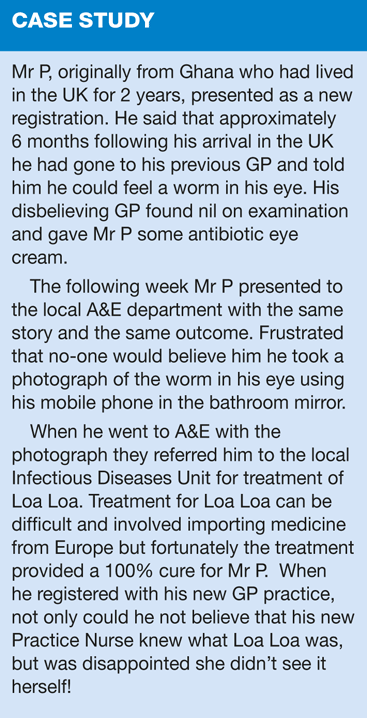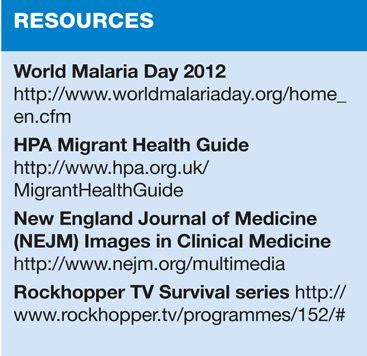Travel medicine: Help! I caught it abroad
Margaret Umeed, RGN MSc. MFTM (RCPSG) FQNIS
Margaret Umeed, RGN MSc. MFTM (RCPSG) FQNIS
Specialist Nurse Practitioner, General Practice, Glasgow
World Malaria Day occurs this week, presenting a timely opportunity for practice nurses to consider the many conditions that patients can acquire when travelling overseas
International travel is increasing. Despite the current economic restrictions facing many of us, travellers are increasingly seeking value for money, a circumstance that often takes them out of their comfort/euro zone and into the realms of tropical climes. With tropical climes, come tropical diseases.
When the series, Help! I caught it Abroad, aired on national television, its viewers were privileged to step behind the scenes at London's Hospital for Tropical Diseases. Included were a couple who had picked up bot fly infections, a woman with a cyst in her brain caused by tapeworms, a man who contracted a sandfly parasite in Greece and a prison officer who lost his lower legs and fingers from a malarial infection contracted in the Gambia.1
Very occasionally the unusual will come our way, like the gentleman who came to register with our practice (see Case Study). However, the majority reading this will be thinking, 'I never see anything unusual', but as practice nurses we do see the uncommon things, and this article is therefore about the things you might just see if you look closely enough!
TRAVELLERS' DIARRHOEA
Travellers' diarrhoea (TD) is the most commonly reported infection in returning travellers, with incidence rates of up to 60% in those visiting some low-income destinations. Those travelling to Africa, Central and South America, the Middle East, South and South East Asia are at particularly high risk. Most cases of TD are caused by bacteria (e.g. Shigella) but enteroviruses and intestinal protozoa such as cyclospora, are also implicated.
The Health Protection Agency (HPA) reports that 24,000 cases of gastrointestinal infections were confirmed between 2004-08. Half of the cases were caused by non-typhoidal salmonella spp which is unaffected by the current typhoid vaccine. The HPA suggests that the number of actual cases of TD may be much higher, due to under reporting and self treatment of mild cases by travellers themselves.2 Intestinal parasites such as worms, are relatively common, especially among long term travellers, ex-pats and those visiting friends and relatives (VFRs). Returning travellers who present with anaemia and eosinophilia should have a stool sample checked for ova, cysts and parasites, as well as for culture, to exclude helminths. A very useful algorithm for returning travellers with diarrhoea can be found in the current NaTHNaC Yellow Book.3
Key Messages for the Traveller4
- Maintain good personal and hand hygiene
- Use of bottled water: carbonated water is more likely to be factory produced
- Boiling (rolling boil for 1 minute) kills all bugs
- Chlorine dioxide is the chemical purification treatment of choice
- Freezing doesn't kill bugs: therefore ice cubes and ice lollies should be avoided unless made with bottled or treated water
- Use pasteurised milk and dairy products (yoghurt, cheese, butter and ice cream)
- Peel fruit or wash with treated / bottled water
- Wash salad with treated / bottled water
- Food should be hot, fresh and cooked all the way through (no rare steaks)
- Avoid shellfish (steaming doesn't kill bugs)
- Avoid reheated rice (reheating doesn't kill spores)
SCHISTOSOMIASIS
Schistosomiasis, or bilharzia at it is sometimes known, is an increasingly common infection contracted following contact with fresh water in infected areas. Common throughout Africa, high-risk destinations include Lake Malawi, Lake Tanganyika and Lake Victoria. Infection also occurs in parts of the Middle East, South East Asia and South America.5 Infection occurs when the free swimming larvae of the blood fluke, called cericariae, come into contact and penetrate the skin of a traveller either swimming or wading in water. Chronic conditions depend on the species of parasite but can include haematuria and liver or intestinal symptoms. A careful post-travel risk assessment is essential in determining whether the traveller may have been at risk from schisotosomiasis. Infection can be confirmed by a urine or blood test approximately 12 weeks post exposure3 and treatment is with the oral drug praziquantel.
Key Messages for the Traveller5
- Avoid direct contact (swimming, wading or showering) with potentially contaminated fresh water
- Avoid drinking, washing or washing clothes in potentially contaminated water
- Chlorine dioxide can be used to treat water to inactivate the cericariae
SEXUALLY TRANSMITTED INFECTIONS
There has been much publicity given to the recent claims that some of the biggest trends in sexually transmitted infections (STIs) are in the over-45 year old age groups.6 Claims that the number of infections such as chlamydia, gonorrhoea, syphilis and HIV have doubled in the past 10 years, are not limited to the UK, with Canada and the US also showing an increase in the numbers of infections in the 45-64 year old age groups.
Traditionally, it is the younger age groups who have been viewed as the biggest risk takers in relation to sexual health when travelling, however the latest data would suggest that travel health advisors should be broadening their base when discussing sexual health with travellers.
Sexual health can be a difficult issue to raise with travellers and health advisors can find it difficult to broach the subject, particularly if the traveller is well known to them as a patient of the practice. One way to raise the issue in a consultation is to discuss the possibility of hepatitis B vaccine. Not every traveller will require immunisation against hepatitis B, but it is worth discussing the ways of contracting the infection, which would lead onto a discussion about other STIs such as HIV and how to protect against infection.
Many travellers will share concerns about requiring unplanned medical care, blood transfusions, treatment with poorly sterilised medical equipment etc but will not necessarily consider themselves at risk from STIs.
Key Messages for the Traveller
- STIs can affect everyone
- Much of the world's population lives with chronic Hepatitis B or C infection
- Although unplanned medical care, inadequately trained health professionals, poorly sterilised medical equipment and infected blood products are implicated in the transmission of blood borne viruses, so is unprotected sexual intercourse
- Take UK bought condoms with you
- Condoms bought abroad can be poorly fitting and will not necessarily meet the UK kite mark standard
- Use a condom every time you have intercourse
- Ask for an STI screen on return to the UK if there has been any unprotected intercourse
MALARIA
World Malaria Day was on Wednesday 25 April. This year's theme was Sustain gains, Save Lives: Invest in Malaria (see sources of information). Globally, malaria caused 216 million clinical cases and killed around 655,000 people last year.7 The majority of cases are in children in endemic areas in Africa, where the disease accounts for approximately 22% of all childhood mortality. Malaria mortality rates since 2000 have fallen by 25% globally and by 33% in the WHO African region, however for UK travellers, malaria remains a constant threat.
A recent paper8 published in the BMJ looked at the malaria mortality data collected in the UK during the past 20 years. Its conclusions were that although most travellers acquiring malaria were of African heritage visiting friends and relatives (VFRs), the risks of dying from malaria was highest in the elderly, in tourists, in those presenting in areas of the UK where malaria is seldom seen, and at times of the year when other influenza-type infections were common i.e. around Christmas and the New Year holidays. Mortality from falciparum malaria remained constant at 1% during the 20-year period, similar to other high income countries, despite the number of imported cases of falciparum malaria increasing during the last 4 years.
Key Messages for the Traveller
- Most cases of malaria in the UK are in individuals born in African countries with endemic malaria who are VFRs
- Data show that the use of malaria chemoprophylaxis in this group of travellers is low
- Mortality from falciparum malaria in the African VFR group is low. This may be in part due to long term immunity acquired when they lived in Africa but may also be due to their awareness of the disease which prompts them to seek early medical attention
- Conversely, tourists travelling to Africa may be unaware that approx 20% of fevers in those returning to the UK from Africa are due to malaria
- Mortality in tourists increases with age
- Those travelling to Gambia as tourists had a strikingly high case fatality. This may reflect the high number of package holidays, with low levels of chemoprophylaxis use and little awareness of malaria on return to the UK
- Every traveller should be aware of the ABCD of malaria (see below) and every travel health provider should be able to discuss its relevance to the traveller in respect of their destination(s).9
ABCD of malaria
- Awareness: of disease, of transmission by mosquitoes, of risk areas in destination
- Bite Avoidance: cover up, use insect repellents containing DEET 20-50%, use impregnated mosquito nets if no air conditioning
- Compliance with chemoprophylaxis: "The use of effective prophylaxis was associated with lower risk of death from malaria in those not born in a country with endemic malaria" 8
- Diagnosis: prompt diagnosis
CONCLUSION
Travel continues to be a growth industry with travellers becoming more adventurous in their travel itineraries. This brings them into contact with infections, parasites, bugs and diseases that their travel advisors may never have heard of. It is every travel health advisor's responsibility to consult within the realms of their competency and advise the traveller appropriately for their proposed trip. TD, schistosomiasis, STIs and malaria are four, not uncommon, post-travel conditions, for which the travel health advisor should be ascertaining the risk, and providing the appropriate information and advice pre-travel. Having a high index of suspicion and knowing who, when and where to refer should the returned traveller require further evaluation is equally important if we are to prevent more travellers from a delayed, possibly life-threatening in the case of malaria, diagnosis.
Conflict of Interest: the author has previously been a member of both the Sanofi Travel Health Vaccine and the GSK Hepatitis B Advisory Boards and has accepted honoraria from both Sanofi Pasteur MSD and GSK.
REFERENCES
1. http://www.prostate-cancer.org.uk/information/1. Woods J. When a tropical trip has a sting in the tail. The Telegraph, 2009. Available at: http://www.telegraph.co.uk/health/6562439/When-a-tropical-trip-has-a-sting-in-the-tail.html [Accessed: 2 April 2012]
2. Health Protection Agency (HPA) Foreign travel-associated illness: a focus of travellers' diarrhoea. 2010 report. London: Health Protection Agency; 2010
3. Field VF, Ford L, Hill DR, eds. Health Information for Overseas Travel. National Travel Health Network and Centre (NaTHNaC), London, UK, 2010.
4. Dawood R, ed. Travellers' Health: how to stay health abroad. 4th edition. Oxford: Oxford University Press; 2002.
5. World Health Organisation (WHO) International Travel and Health. Geneva: WHO; 2011
6. von Simson B, Kulasegaram R. Sexual Health and the older adult. Student British Medical Journal (BMJ) 2012;20:e688. Available at: http://student.bmj.com/student/view-article.html?id=sbmj.e688 [Accessed: 2 April 2012]
7. World Health Organisation (WHO) Malaria information pages http://www.who.int/mediacentre/factsheets/fs094/en/index.html [Accessed: 2 April 2012]
8. Checkley A M, Smith A, Smith V, Blaze M, Bradley D, Chiodini P, Whitty C. Risk Factors for mortality from imported falciparum malaria in the United Kingdom over 20 years: an observational study. BMJ 2012;344:e2116
9. Chiodini P, Hill D, Laloo D, Lea G, Walker E, Whitty C, Bannister B. Guidelines for malaria prevention in travellers from the United Kingdom. London, Health Protection Agency, 2007.
Related articles
View all Articles

